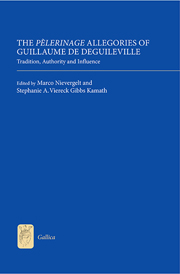Book contents
- Frontmatter
- Contents
- List of Illustrations
- List of Contributors
- Acknowledgements
- Abbreviations
- Introduction
- Part I Tradition
- 1 The Pèlerinage corpus: A Tradition of Textual Transformation across Western Europe
- 2 Manuscrits à voir, manuscrits à lire, manuscrits lus: les marginalia du Pèlerinage de Vie Humaine comme indices de sa réception médiévale
- 3 Rewriting Joseph in the life of christ: The Allegory of the Raptor-Thieves in the Pèlerinage de Jhesucrist
- Part II Authority
- Part III Influence
- Bibliography
- Index
3 - Rewriting Joseph in the life of christ: The Allegory of the Raptor-Thieves in the Pèlerinage de Jhesucrist
from Part I - Tradition
Published online by Cambridge University Press: 05 December 2013
- Frontmatter
- Contents
- List of Illustrations
- List of Contributors
- Acknowledgements
- Abbreviations
- Introduction
- Part I Tradition
- 1 The Pèlerinage corpus: A Tradition of Textual Transformation across Western Europe
- 2 Manuscrits à voir, manuscrits à lire, manuscrits lus: les marginalia du Pèlerinage de Vie Humaine comme indices de sa réception médiévale
- 3 Rewriting Joseph in the life of christ: The Allegory of the Raptor-Thieves in the Pèlerinage de Jhesucrist
- Part II Authority
- Part III Influence
- Bibliography
- Index
Summary
For a well-read medieval monk, as Guillaume de Deguileville must have been, remembering what he read involved memory techniques centered on the visualization of unusual, if not bizarre and startling, scenes and figures. Thus, as a writer who wanted his writing to be remembered, Deguileville conveyed the content of his three Pèlerinages through vivid and detailed descriptions of unusual figures and scenes, including interactions between personifications and biblical characters, which beg for visualization. Apparently unwilling to rely entirely on the reader's ability to create these memory-images in the imagination, the author himself planned for some illustrations, though we cannot know whether he devised complete programs of miniatures or supervised the production of any illustrated manuscripts. Each of his three French pilgrimage poems appeared individually with illustrations, but manuscripts that collect all three Pèlerinages include some of the most ambitious programs of illustration. It is as if the desire for uniformity stimulated designers and artists to continue the dense level of visualization frequently found in manuscripts of the PVH into the other two poems. Images, in fact, provide the most striking evidence for the high level of familiarity with Deguileville's three Pèlerinages from the late fourteenth to mid-fifteenth centuries: in the book of hours known as the Hours of Isabella Stuart (Cambridge, Fitzwilliam Museum MS 62), picture cycles for each of the poems – in the unusual sequence PJC, PVH, PA – accompany not Deguileville's poems but the familiar cycle of texts found in this personal book of hours, an indication that the images alone enabled readers to recall the poems.
- Type
- Chapter
- Information
- The Pèlerinage Allegories of Guillaume de DeguilevilleTradition, Authority and Influence, pp. 65 - 88Publisher: Boydell & BrewerPrint publication year: 2013

